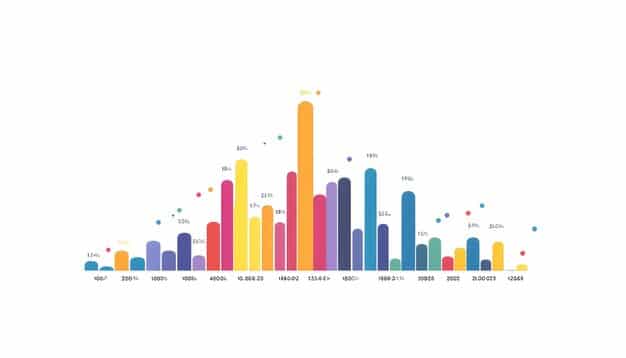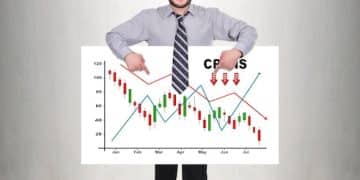Investing 101: Harnessing Compounding Interest for Maximum Returns

Investing 101 emphasizes the significance of understanding compounding interest, where earnings generate further earnings, accelerating wealth accumulation over time and highlighting strategies to calculate and maximize these returns for long-term financial growth.
Embarking on your investment journey? Understanding the power of Investing 101: Understanding the Power of Compounding Interest and How to Calculate Your Returns is crucial. It’s the cornerstone of long-term wealth building, turning small initial investments into substantial future gains. Let’s dive in!
Understanding the Basics of Investing
Investing can seem daunting at first, but breaking down the basics simplifies the process. It’s essentially allocating money with the expectation of generating future income or profit. This could be through various avenues, each with its own risk-reward profile.
What is Investing?
Investing is the act of deploying capital to purchase an asset or item with the goal of increasing its value over time. It’s about making your money work for you, rather than letting it sit idly in a savings account.
Why Should You Invest?
Investing offers the potential to grow your wealth at a rate greater than inflation, securing your financial future. It can help you achieve financial goals like early retirement, buying a home, or funding your children’s education.
- Beat Inflation: Keep your purchasing power ahead of rising costs.
- Achieve Financial Goals: Plan for major life events and secure your future.
- Generate Passive Income: Create a steady stream of income through dividends or interest.
In essence, understanding the basics of investing is the first step towards financial empowerment. By grasping what it is and why it’s important, you set the stage for making informed decisions that can significantly impact your financial well-being.

The Magic of Compounding Interest
Compounding interest is often hailed as the eighth wonder of the world. It’s the process where the interest you earn on your initial investment also earns interest. Over time, this snowball effect can lead to significant growth in your investments.
What is Compounding Interest?
Compounding interest means earning interest on your initial principal as well as on the accumulated interest from prior periods. It’s like your money making money, and then that money making even more money.
The Formula for Compounding Interest
The formula for calculating compounding interest is: A = P (1 + r/n)^(nt), where A is the future value of the investment/loan, including interest, P is the principal investment amount (the initial deposit or loan amount), r is the annual interest rate (as a decimal), n is the number of times that interest is compounded per year, and t is the number of years the money is invested or borrowed for.
- Future Value (A): The total amount you’ll have at the end of the investment period.
- Principal (P): The initial amount you invest.
- Interest Rate (r): The annual rate of return on your investment.
Understanding and leveraging compounding interest is key to maximizing your investment returns. It’s a powerful tool that can accelerate your wealth accumulation over the long term, making it an essential concept for any investor.
Calculating Your Compounding Returns: A Step-by-Step Guide
Calculating your potential compounding returns may seem complex, but with a step-by-step approach and some practical examples, it becomes quite manageable. Knowing how to project your returns can help you make informed investment decisions.
Step 1: Gather Your Information
Before you start calculating, gather all the necessary information: the initial investment amount (principal), the annual interest rate, the compounding frequency (annually, semi-annually, quarterly, monthly, daily), and the investment time horizon.
Step 2: Understand the Formula
Reiterate the compounding interest formula: A = P (1 + r/n)^(nt). Make sure you understand each component and how it contributes to the final calculation.
Step 3: Work Through Practical Examples
Let’s say you invest $1,000 (P) at an annual interest rate of 5% (r) compounded annually (n = 1) for 10 years (t). Using the formula: A = 1000 (1 + 0.05/1)^(1*10) = $1,628.89. This means your initial investment would grow to $1,628.89 over 10 years.

Factors Affecting Compounding Interest
Several factors can influence the effectiveness of compounding interest. Understanding these factors can help you make strategic investment decisions that maximize your returns over time.
Interest Rate
The interest rate is a primary driver of compounding returns. A higher interest rate leads to faster growth. Even small differences in interest rates can result in significant variations in your long-term returns.
Time Horizon
The longer your investment period, the greater the impact of compounding. Time allows the snowball effect to take hold, and the more time you have, the more exponential the growth becomes.
Compounding Frequency
The more frequently interest is compounded, the faster your money grows. For instance, daily compounding will yield slightly higher returns than annual compounding, given the same interest rate and time horizon.
- Maximize Interest Rate: Seek investments with competitive rates.
- Extend Time Horizon: Invest early and stay invested for the long haul.
- Consider Compounding Frequency: Understand how often interest is compounded to maximize returns.
By understanding and optimizing these factors, you can harness the full potential of compounding interest, accelerating your wealth accumulation and securing your financial future.
Strategies for Maximizing Compounding Returns
To fully leverage the power of compounding interest, consider implementing specific strategies that can help you maximize your returns over the long term. These strategies involve making smart choices about when and how to invest.
Start Early
The earlier you start investing, the more time your money has to grow through compounding. Even small amounts invested early can accumulate into substantial sums over several decades.
Reinvest Dividends and Earnings
When your investments generate dividends or earnings, reinvest them. This allows you to buy more shares or assets, further accelerating the compounding effect.
Increase Contributions Over Time
As your income grows, increase your investment contributions. Boosting your contributions periodically can significantly amplify the impact of compounding interest on your overall returns.
Common Mistakes to Avoid
To make the most of compounding interest, it’s important to avoid common mistakes that can derail your investment progress. Being aware of these pitfalls can help you stay on track and achieve your financial goals.
Not Starting Early Enough
Procrastinating on investing can cost you dearly. The later you start, the less time your money has to benefit from compounding, and the more you’ll need to invest to catch up.
Withdrawing Funds Early
Withdrawing funds prematurely can disrupt the compounding process. Each withdrawal reduces the base on which future interest is calculated, slowing down your wealth accumulation.
Ignoring Fees and Taxes
Fees and taxes can eat into your returns, reducing the overall effectiveness of compounding interest. Be mindful of these costs and choose investments with reasonable fees and tax implications.
- Avoiding Procrastination: Start investing as soon as possible to maximize time.
- Resisting Early Withdrawals: Keep your funds invested to maintain the compounding effect.
- Being Fee and Tax-Aware: Minimize costs to optimize your returns.
Avoiding these common mistakes is crucial for maintaining a clear path towards achieving your long-term financial goals. By being diligent and informed, you can avoid these common pitfalls and ensure your investments continue to grow effectively through compounding interest.
| Key Concept | Brief Description |
|---|---|
| 🚀 Compounding | Interest on interest, accelerating wealth growth. |
| ⏳ Time Matters | Early investing maximizes compounding benefits. |
| 💰 Reinvesting | Reinvest earnings for amplified compounding. |
| 🚫 Avoid Pitfalls | Minimize fees and resist early withdrawals. |
Frequently Asked Questions
▼
The basic principle is earning interest not only on the initial principal but also on the accumulated interest from previous periods, leading to exponential growth over time.
▼
More frequent compounding (e.g., daily) results in slightly higher returns than less frequent compounding (e.g., annually) due to interest being added and recalculated more often.
▼
Starting early provides a longer time horizon, allowing the compounding effect to accumulate significantly over the years, turning even small investments into substantial sums.
▼
Common mistakes include delaying investments, withdrawing funds prematurely, and ignoring fees and taxes, all of which reduce the potential benefits of compounding interest.
▼
Yes, reinvesting dividends allows you to purchase more shares or assets, further amplifying the compounding effect and accelerating the overall growth of your investment portfolio.
Conclusion
Understanding and harnessing the power of Investing 101: Understanding the Power of Compounding Interest and How to Calculate Your Returns is fundamental to successful long-term investing. By starting early, reinvesting earnings, and avoiding common pitfalls, you can leverage compounding to achieve your financial goals and secure your future.





